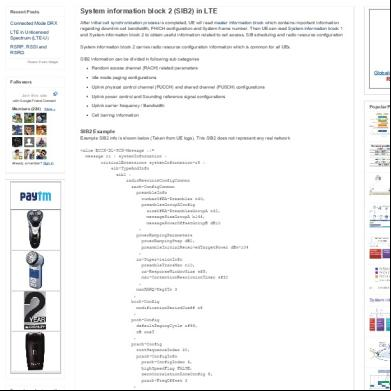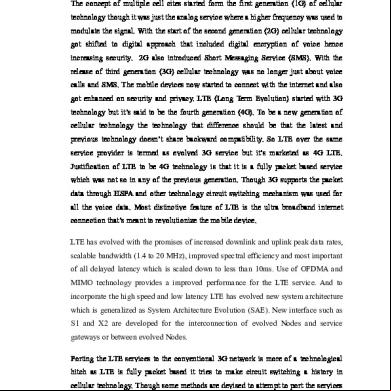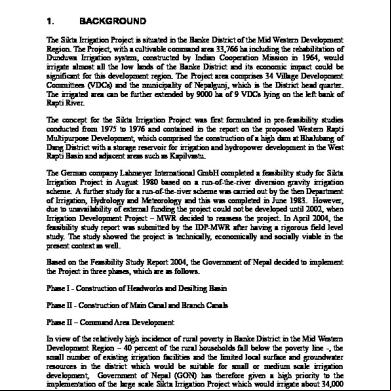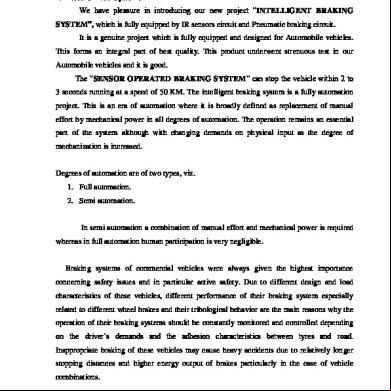3gpp Long Term Evolution (lte)information Block 2 (sib2) In Lte 1m5q5m
This document was ed by and they confirmed that they have the permission to share it. If you are author or own the copyright of this book, please report to us by using this report form. Report 3b7i
Overview 3e4r5l
& View 3gpp Long Term Evolution (lte)information Block 2 (sib2) In Lte as PDF for free.
More details w3441
- Words: 1,941
- Pages: 5
1
More Next Blog»
3GPP Long Term Evolution (LTE) LTE is a standard for wireless communication based on 3GPP technologies, promising highspeed data for mobile phones and data terminals Home
LTE Frequency Bands
Recent Posts
Connected Mode DRX LTE in Unlicensed Spectrum (LTEU) RSRP, RSSI and RSRQ Recent Posts Widget
Quiz
LTE Throughput Calculator
3GPP releases summary
System information block 2 (SIB2) in LTE After initial cell synchronization process is completed, UE will read master information block which contains important information regarding downlink cell bandwidth, PHICH configuration and System frame number. Then UE can read System information block 1 and System information block 2 to obtain useful information related to cell access, SIB scheduling and radio resource configuration System information block 2 carries radio resource configuration information which is common for all UEs. SIB2 information can be divided in following sub categories Random access channel (RACH) related parameters Idle mode paging configurations
Followers
Globalit
R
Uplink physical control channel (PUCCH) and shared channel (PUSCH) configurations
this site with Google Friend Connect
(224) More »
Uplink power control and Sounding reference signal configurations Uplink carrier frequency / Bandwidth
Popular P
Cell barring information
SIB2 Example Example SIB2 info is shown below (Taken from UE logs). This SIB2 does not represent any real network
Already a member? Sign in
Pageviews last month
28,155 Live Traffic Feed
value BCCHDLSCHMessage ::= message c1 : systemInformation : criticalExtensions systemInformationr8 : sibTypeAndInfo sib2 : radioResourceConfigCommon rachConfigCommon preambleInfo numberOfRAPreambles n40, preamblesGroupAConfig sizeOfRAPreamblesGroupA n32, messageSizeGroupA b144, messagePowerOffsetGroupB dB10 , powerRampingParameters powerRampingStep dB2, preambleInitialReceivedTargetPower dBm104 , raSupervisionInfo preambleTransMax n10, raResponseWindowSize sf5, macContentionResolutionTimer sf32 , maxHARQMsg3Tx 3 , bcchConfig modificationPeriodCoeff n8 , pcchConfig defaultPagingCycle rf64, nB oneT , prachConfig rootSequenceIndex 30, prachConfigInfo prachConfigIndex 4, highSpeedFlag FALSE, zeroCorrelationZoneConfig 8, prachFreqOffset 3 , pdschConfigCommon referenceSignalPower 11, pb 1 , puschConfigCommon puschConfigBasic nSB 1, hoppingMode interSubFrame, puschHoppingOffset 6,
System inf
Search Th
Live Traffic Feed A visitor from Gurgaon, Haryana viewed "3GPP Long Term Evolution (LTE): System information block 2 A visitor from Korea, (SIB2) in LTE" 1 min ago Republic of viewed "3GPP Long Term Evolution (LTE): Default Bearer, Dedicated Bearer... What exactly is A visitor from Singapore bearer ?" 2 mins ago viewed "3GPP Long Term Evolution (LTE): RSRP, RSSI and RSRQ" A visitor from Central 4 mins ago District viewed "3GPP Long Term Evolution (LTE): RSRP, RSSI and A visitor from India RSRQ" 4 mins ago viewed "3GPP Long Term Evolution (LTE): RSRP, RSSI and RSRQ" A visitor from India 6 mins ago viewed "3GPP Long Term Evolution (LTE): Transport Block Size, Realtime view · Get Feedjit
Blog Archive ► 2015 (7) ► 2014 (1) ▼ 2013 (5) ► September (1) ► April (1) ► March (1) ▼ February (1) System informati on block 2 (SIB2) in LTE ► January (1) ► 2012 (20)
About This Blog The views expressed in this blog are my own and in no way reflect the views of my employer. I hope this sharing of knowledge will not only be beneficial to others, but a great learning experience for myself too Adnan
enable64QAM FALSE , ulReferenceSignalsPUSCH groupHoppingEnabled FALSE, grouignmentPUSCH 0, sequenceHoppingEnabled FALSE, cyclicShift 0 , pucchConfigCommon deltaPUCCHShift ds2, nRBCQI 1, nCSAN 0, n1PUCCHAN 36 , soundingRSULConfigCommon release : NULL, uplinkPowerControlCommon p0NominalPUSCH 100, alpha al1, p0NominalPUCCH 100, deltaFListPUCCH deltaFPUCCHFormat1 deltaF0, deltaFPUCCHFormat1b deltaF1, deltaFPUCCHFormat2 deltaF0, deltaFPUCCHFormat2a deltaF0, deltaFPUCCHFormat2b deltaF0 , deltaPreambleMsg3 1 , ulCyclirefixLength len1 , ueTimersAndConstants t300 ms200, t301 ms200, t310 ms500, n310 n10, t311 ms3000, n311 n1 , freqInfo ulCarrierFreq 20600, ulBandwidth n50, additionalSpectrumEmission 12 , timeAlignmentTimerCommon sf10240
Translate
Select
Guava
Lancer
Labels
3GPP (1) 5G ANR (1) Auth (1) CA (1)
search (3)
Control Chan
bearer (2)
Definition of important Parameters
timer (1) eIC protocol (1) g
Rach Configurations
(3) interferen
numberOfRAPreambles: Total number of random access preambles available for contention based random access. Since there are maximum 64 preambles sequences available, others could be reserved by eNB for NonContention based random access. Range of this parameter is 4 to 64 sizeOfRAPreamblesGroupA: Total number of random access preambles sequences available within Group A. Preambles are divided into Group A and Group B. Group A preambles are intended for sending small packets and Group B preambles are intended for sending large packets. Range of this parameter is 4 to 60 messageSizeGroupA: Message size threshold for selecting preamble Group A in term of bits (56, 144, 208 or 256 bits) messagePowerOffsetGroupB: Power offset for selecting preamble Group B (0, 5, 8, 10, 12, 15 or 18 dB) powerRampingStep: power ramping step size with possible values of 0, 2, 4 or 6 dB preambleInitialReceivedTargetPower: Preamble initial received target power with values from 120 dBm to 90 dBm with step size of 2 dBm preambleTransMax: Maximum number of preambles transmissions. Possible values are 3, 4, 5, 6, 7, 8, 10 ,20, 50, 100, 200. raResponseWindowSize: Duration of RA response window. RA response window size is in unit of subframes (2, 3, 4, 5, 6, 7, 8, or 10 subframes) macContentionResolutionTimer: Mac contention resolution timer in unit of subframes (8, 16, 24, 32, 40, 58, 56 or 64 subframes) maxHARQMsg3Tx: Maximum number of HARQ retransmissions for message 3 of RACH process (contentionbased Random access) with possible values from 1 to 8 in step of 1
BCCH Configurations modificationPeriodCoeff: The value (2,4,6,8) of this parameter is multiplied with default DRX cycle (e.g. 320ms, 640ms) to generate the BCCH modification period. It is the period in which the change in SI is repeated to UEs so that the change in SI is acquired by UE. BCCH modification period = modificationPeriodCoeff x idle mode DRX cycle
(12)
LT
measurement
Over the Top PCRF (1) PD
QCI (1) QO
access proce 12 (1) releas RoHC (1) roll connection r connection se RSRQ (1) R signaling (1)
synchronizatio
LTE (1) thro
size (1) TTI b
(1) voip (2) v
Recomm
Lo Ev
Ch
$7
Th D H
(H
PCCH Configurations defaultPagingCycle: The default DRX cycle in idle mode in unit of radio frames (rf64 means 640ms ) nB: This parameter value is used in finding the actual paging frames and paging occasions in RRC idle mode with the following formula SFN modT = (T/N) x (UE_ID mod N) Where
$1
Get Widge
T = Drx cycle N = Min (T, nB) (nB is broadcasted in SIB2) UE_ID = IMSI mod 1024
PRACH Configurations rootSequenceIndex: RA preambles are generated from Zadoff Chu sequence which consists of series of root sequences. Each root sequence can be cyclic shifted to obtain preamble sequence. Range of rootSequenceIndex is 0 to 837. prachConfigIndex: This parameter defines exactly when UE should send RACH in frequency/time grids (Details TS36.211 Table 5.7.12) highSpeedFlag: For high speed UEs , as this can impact the correlation between cycles zeroCorrelationZoneConfig: The zero correlation zone is used to guarantee orthogonality of generated sequences. The value depends on particular condition in the cell prachFreqOffset: With this information cell informs UE and other neighbor cells know about which PRB is available for RACH access
PDSCH Configurations referenceSignalPower: This defines the energy per resource element for the reference signal using a range from 60 to 50 dBm. pb: It is used to calculate the power difference between PDSCH and Reference Signal. Value is from 0 to 3
PUSCH Configurations nSB: Number of subbands (range 1 to 4) hoppingMode: Hopping mode can be intersubframe, intra or intersubframe puschHoppingOffset: Offset values range from 1 to 98 enable64QAM: if 64QAM capable UE should use it (True or False) groupHoppingEnabled: True or False grouignmentPUSCH: Gives sequence shift pattern for group hopping (0 to 29) sequenceHoppingEnabled: True or False cyclicShift: Frequency shift for demodulation (0 to 7)
PUCCH Config deltaPUCCHShift: 1,2 or 3 nRBCQI: Number of PRBs per slot for PUCCH2 (0 to 98) nCSAN: Cyclic shift used for PUCCH1 (0 to 7) n1PUCCHAN: PUCCH to be used for HARQ (0 TO 2047)
Sounding Reference Signaling Configurations: The uplink Sounding Reference Signal (SRS) is configured in of bandwidth and subframes
Uplink Power Control p0NominalPUSCH: It impacts the calculation of PUSCH transmit power and applicable to nonpersistent scheduling only (126 to 24 dBm) alpha: It also impacts the calculation of PUSCH transmit power and also scales the contribution of path loss. Possible values are 0, 0.4, 0.5, 0.6, 0.7, 0.8, 0.9 and 1 p0NominalPUCCH: This parameter impacts the calculation of PUCCH transmit power (127 to 96 dBm) deltaFListPUCCH: These parameters impacts the calculation of PUCCH transmit power deltaPreambleMsg3: It impacts the transmit power of PUSCH when responding to random access response grant (1 to 6dB) ulCyclirefixLength: To differentitate between normal (len1) OR extended (len2) cyclic prefix for uplink transmission
UE Timers and Constants T300: Time during which UE waits for RRC connection request message response (100, 200, 300, 400, 600, 1000, 1500, 2000 ms) T301: Started after RRC Connection Reestablishment request message. On expiration UE will go to RRC idle (100, 200, 300, 400, 600, 1000, 1500, 2000 ms) T310: Started after receiving N310 out of sync indications (0, 50, 100, 200, 500, 1000, 2000 ms) T311: Started after initiating connection reestablishment procedure. On expiration UE goes to RRC idle mode if it is unable to locate suitable cell (1, 3, 5, 10, 15, 20, 30 seconds) N310: Consecutive out of sync indications (1, 2, 3, 4, 6, 8, 10, 20) N311: Consecutive insync indications (1, 2, 3, 4, 6, 8, 10, 20)
Frequency Information ulCarrierFreq: Defined in of EARFCN ulBandwidth: Defined in of resource blocks additionalSpectrumEmission: This allows spectrum emission limits to be configured according to local requirements (1 to 32) timeAlignmentTimerCommon: it tells UE how long it should consider itself to be time aligned in uplink in unit of subframes. (500, 750, 1280, 1920, 2560, 5120, 10240 or infinity subframes)
+1 Recommend this on Google
Labels: LTE, SIB2, System Information blocks
10 comments: Rachel Johnson October 12, 2013 at 12:53 AM
Please visit website www.telecomtube.com for telecom jobs. Thanks Reply
Rachel Johnson October 12, 2013 at 12:53 AM Please visit website www.telecomtube.com for telecom jobs. Thanks Reply
Rachel Johnson October 12, 2013 at 12:55 AM This comment has been removed by the author. Reply
Bharath K Asrani May 11, 2014 at 1:35 PM Thanks for the detailed article. Could you please provide references" mentioned. Thanks. Reply
Marcos Graciano Santos May 29, 2014 at 9:21 AM This comment has been removed by the author. Reply
Marcos Graciano Santos May 29, 2014 at 9:29 AM Hi, Adnan "System information block 2 carries radio resource configuration information which is common for all UEs" but each UE receive a particular SIB2, or it is broadcasting how the SIB1? If I want to send a specific powerRampingStep or pMax (SIB1) for a especific UE, can I do it? Reply
Unknown December 18, 2014 at 2:25 AM raResponseWindowSize : ENUMERATED { sf2, sf3, sf4, sf5, sf6, sf7,sf8, sf10} macContentionResolutionTimer : ENUMERATED {sf8, sf16, sf24, sf32, sf40, sf48,sf56, sf64} Specified in 3GPP TS 36.331 section 6.3.2 and 3GPP TS 36.321 section 5.1.4 Reply
arshdeep kaur January 29, 2015 at 1:03 AM How is UE informed the value of Backoff_Indiactor? Reply Replies Rishi Sinha April 30, 2015 at 2:26 AM It goes as a tail to RAR. Check 36.221 Reply
Abhisek Patra July 1, 2015 at 5:14 AM is ulBandwidth broadcasted in SIB2 for TDD also ? Reply
Enter your comment...
Comment as:
sagar (Google) Sign out
Publish
Notify me
Preview
Links to this post Create a Link
Newer Post
Home
Older Post
Subscribe to: Post Comments (Atom)
You may reproduce the content of this website only if you provide this website as original source. Awesome Inc. template. Powered by Blogger.
More Next Blog»
3GPP Long Term Evolution (LTE) LTE is a standard for wireless communication based on 3GPP technologies, promising highspeed data for mobile phones and data terminals Home
LTE Frequency Bands
Recent Posts
Connected Mode DRX LTE in Unlicensed Spectrum (LTEU) RSRP, RSSI and RSRQ Recent Posts Widget
Quiz
LTE Throughput Calculator
3GPP releases summary
System information block 2 (SIB2) in LTE After initial cell synchronization process is completed, UE will read master information block which contains important information regarding downlink cell bandwidth, PHICH configuration and System frame number. Then UE can read System information block 1 and System information block 2 to obtain useful information related to cell access, SIB scheduling and radio resource configuration System information block 2 carries radio resource configuration information which is common for all UEs. SIB2 information can be divided in following sub categories Random access channel (RACH) related parameters Idle mode paging configurations
Followers
Globalit
R
Uplink physical control channel (PUCCH) and shared channel (PUSCH) configurations
this site with Google Friend Connect
(224) More »
Uplink power control and Sounding reference signal configurations Uplink carrier frequency / Bandwidth
Popular P
Cell barring information
SIB2 Example Example SIB2 info is shown below (Taken from UE logs). This SIB2 does not represent any real network
Already a member? Sign in
Pageviews last month
28,155 Live Traffic Feed
value BCCHDLSCHMessage ::= message c1 : systemInformation : criticalExtensions systemInformationr8 : sibTypeAndInfo sib2 : radioResourceConfigCommon rachConfigCommon preambleInfo numberOfRAPreambles n40, preamblesGroupAConfig sizeOfRAPreamblesGroupA n32, messageSizeGroupA b144, messagePowerOffsetGroupB dB10 , powerRampingParameters powerRampingStep dB2, preambleInitialReceivedTargetPower dBm104 , raSupervisionInfo preambleTransMax n10, raResponseWindowSize sf5, macContentionResolutionTimer sf32 , maxHARQMsg3Tx 3 , bcchConfig modificationPeriodCoeff n8 , pcchConfig defaultPagingCycle rf64, nB oneT , prachConfig rootSequenceIndex 30, prachConfigInfo prachConfigIndex 4, highSpeedFlag FALSE, zeroCorrelationZoneConfig 8, prachFreqOffset 3 , pdschConfigCommon referenceSignalPower 11, pb 1 , puschConfigCommon puschConfigBasic nSB 1, hoppingMode interSubFrame, puschHoppingOffset 6,
System inf
Search Th
Live Traffic Feed A visitor from Gurgaon, Haryana viewed "3GPP Long Term Evolution (LTE): System information block 2 A visitor from Korea, (SIB2) in LTE" 1 min ago Republic of viewed "3GPP Long Term Evolution (LTE): Default Bearer, Dedicated Bearer... What exactly is A visitor from Singapore bearer ?" 2 mins ago viewed "3GPP Long Term Evolution (LTE): RSRP, RSSI and RSRQ" A visitor from Central 4 mins ago District viewed "3GPP Long Term Evolution (LTE): RSRP, RSSI and A visitor from India RSRQ" 4 mins ago viewed "3GPP Long Term Evolution (LTE): RSRP, RSSI and RSRQ" A visitor from India 6 mins ago viewed "3GPP Long Term Evolution (LTE): Transport Block Size, Realtime view · Get Feedjit
Blog Archive ► 2015 (7) ► 2014 (1) ▼ 2013 (5) ► September (1) ► April (1) ► March (1) ▼ February (1) System informati on block 2 (SIB2) in LTE ► January (1) ► 2012 (20)
About This Blog The views expressed in this blog are my own and in no way reflect the views of my employer. I hope this sharing of knowledge will not only be beneficial to others, but a great learning experience for myself too Adnan
enable64QAM FALSE , ulReferenceSignalsPUSCH groupHoppingEnabled FALSE, grouignmentPUSCH 0, sequenceHoppingEnabled FALSE, cyclicShift 0 , pucchConfigCommon deltaPUCCHShift ds2, nRBCQI 1, nCSAN 0, n1PUCCHAN 36 , soundingRSULConfigCommon release : NULL, uplinkPowerControlCommon p0NominalPUSCH 100, alpha al1, p0NominalPUCCH 100, deltaFListPUCCH deltaFPUCCHFormat1 deltaF0, deltaFPUCCHFormat1b deltaF1, deltaFPUCCHFormat2 deltaF0, deltaFPUCCHFormat2a deltaF0, deltaFPUCCHFormat2b deltaF0 , deltaPreambleMsg3 1 , ulCyclirefixLength len1 , ueTimersAndConstants t300 ms200, t301 ms200, t310 ms500, n310 n10, t311 ms3000, n311 n1 , freqInfo ulCarrierFreq 20600, ulBandwidth n50, additionalSpectrumEmission 12 , timeAlignmentTimerCommon sf10240
Translate
Select
Guava
Lancer
Labels
3GPP (1) 5G ANR (1) Auth (1) CA (1)
search (3)
Control Chan
bearer (2)
Definition of important Parameters
timer (1) eIC protocol (1) g
Rach Configurations
(3) interferen
numberOfRAPreambles: Total number of random access preambles available for contention based random access. Since there are maximum 64 preambles sequences available, others could be reserved by eNB for NonContention based random access. Range of this parameter is 4 to 64 sizeOfRAPreamblesGroupA: Total number of random access preambles sequences available within Group A. Preambles are divided into Group A and Group B. Group A preambles are intended for sending small packets and Group B preambles are intended for sending large packets. Range of this parameter is 4 to 60 messageSizeGroupA: Message size threshold for selecting preamble Group A in term of bits (56, 144, 208 or 256 bits) messagePowerOffsetGroupB: Power offset for selecting preamble Group B (0, 5, 8, 10, 12, 15 or 18 dB) powerRampingStep: power ramping step size with possible values of 0, 2, 4 or 6 dB preambleInitialReceivedTargetPower: Preamble initial received target power with values from 120 dBm to 90 dBm with step size of 2 dBm preambleTransMax: Maximum number of preambles transmissions. Possible values are 3, 4, 5, 6, 7, 8, 10 ,20, 50, 100, 200. raResponseWindowSize: Duration of RA response window. RA response window size is in unit of subframes (2, 3, 4, 5, 6, 7, 8, or 10 subframes) macContentionResolutionTimer: Mac contention resolution timer in unit of subframes (8, 16, 24, 32, 40, 58, 56 or 64 subframes) maxHARQMsg3Tx: Maximum number of HARQ retransmissions for message 3 of RACH process (contentionbased Random access) with possible values from 1 to 8 in step of 1
BCCH Configurations modificationPeriodCoeff: The value (2,4,6,8) of this parameter is multiplied with default DRX cycle (e.g. 320ms, 640ms) to generate the BCCH modification period. It is the period in which the change in SI is repeated to UEs so that the change in SI is acquired by UE. BCCH modification period = modificationPeriodCoeff x idle mode DRX cycle
(12)
LT
measurement
Over the Top PCRF (1) PD
QCI (1) QO
access proce 12 (1) releas RoHC (1) roll connection r connection se RSRQ (1) R signaling (1)
synchronizatio
LTE (1) thro
size (1) TTI b
(1) voip (2) v
Recomm
Lo Ev
Ch
$7
Th D H
(H
PCCH Configurations defaultPagingCycle: The default DRX cycle in idle mode in unit of radio frames (rf64 means 640ms ) nB: This parameter value is used in finding the actual paging frames and paging occasions in RRC idle mode with the following formula SFN modT = (T/N) x (UE_ID mod N) Where
$1
Get Widge
T = Drx cycle N = Min (T, nB) (nB is broadcasted in SIB2) UE_ID = IMSI mod 1024
PRACH Configurations rootSequenceIndex: RA preambles are generated from Zadoff Chu sequence which consists of series of root sequences. Each root sequence can be cyclic shifted to obtain preamble sequence. Range of rootSequenceIndex is 0 to 837. prachConfigIndex: This parameter defines exactly when UE should send RACH in frequency/time grids (Details TS36.211 Table 5.7.12) highSpeedFlag: For high speed UEs , as this can impact the correlation between cycles zeroCorrelationZoneConfig: The zero correlation zone is used to guarantee orthogonality of generated sequences. The value depends on particular condition in the cell prachFreqOffset: With this information cell informs UE and other neighbor cells know about which PRB is available for RACH access
PDSCH Configurations referenceSignalPower: This defines the energy per resource element for the reference signal using a range from 60 to 50 dBm. pb: It is used to calculate the power difference between PDSCH and Reference Signal. Value is from 0 to 3
PUSCH Configurations nSB: Number of subbands (range 1 to 4) hoppingMode: Hopping mode can be intersubframe, intra or intersubframe puschHoppingOffset: Offset values range from 1 to 98 enable64QAM: if 64QAM capable UE should use it (True or False) groupHoppingEnabled: True or False grouignmentPUSCH: Gives sequence shift pattern for group hopping (0 to 29) sequenceHoppingEnabled: True or False cyclicShift: Frequency shift for demodulation (0 to 7)
PUCCH Config deltaPUCCHShift: 1,2 or 3 nRBCQI: Number of PRBs per slot for PUCCH2 (0 to 98) nCSAN: Cyclic shift used for PUCCH1 (0 to 7) n1PUCCHAN: PUCCH to be used for HARQ (0 TO 2047)
Sounding Reference Signaling Configurations: The uplink Sounding Reference Signal (SRS) is configured in of bandwidth and subframes
Uplink Power Control p0NominalPUSCH: It impacts the calculation of PUSCH transmit power and applicable to nonpersistent scheduling only (126 to 24 dBm) alpha: It also impacts the calculation of PUSCH transmit power and also scales the contribution of path loss. Possible values are 0, 0.4, 0.5, 0.6, 0.7, 0.8, 0.9 and 1 p0NominalPUCCH: This parameter impacts the calculation of PUCCH transmit power (127 to 96 dBm) deltaFListPUCCH: These parameters impacts the calculation of PUCCH transmit power deltaPreambleMsg3: It impacts the transmit power of PUSCH when responding to random access response grant (1 to 6dB) ulCyclirefixLength: To differentitate between normal (len1) OR extended (len2) cyclic prefix for uplink transmission
UE Timers and Constants T300: Time during which UE waits for RRC connection request message response (100, 200, 300, 400, 600, 1000, 1500, 2000 ms) T301: Started after RRC Connection Reestablishment request message. On expiration UE will go to RRC idle (100, 200, 300, 400, 600, 1000, 1500, 2000 ms) T310: Started after receiving N310 out of sync indications (0, 50, 100, 200, 500, 1000, 2000 ms) T311: Started after initiating connection reestablishment procedure. On expiration UE goes to RRC idle mode if it is unable to locate suitable cell (1, 3, 5, 10, 15, 20, 30 seconds) N310: Consecutive out of sync indications (1, 2, 3, 4, 6, 8, 10, 20) N311: Consecutive insync indications (1, 2, 3, 4, 6, 8, 10, 20)
Frequency Information ulCarrierFreq: Defined in of EARFCN ulBandwidth: Defined in of resource blocks additionalSpectrumEmission: This allows spectrum emission limits to be configured according to local requirements (1 to 32) timeAlignmentTimerCommon: it tells UE how long it should consider itself to be time aligned in uplink in unit of subframes. (500, 750, 1280, 1920, 2560, 5120, 10240 or infinity subframes)
+1 Recommend this on Google
Labels: LTE, SIB2, System Information blocks
10 comments: Rachel Johnson October 12, 2013 at 12:53 AM
Please visit website www.telecomtube.com for telecom jobs. Thanks Reply
Rachel Johnson October 12, 2013 at 12:53 AM Please visit website www.telecomtube.com for telecom jobs. Thanks Reply
Rachel Johnson October 12, 2013 at 12:55 AM This comment has been removed by the author. Reply
Bharath K Asrani May 11, 2014 at 1:35 PM Thanks for the detailed article. Could you please provide references" mentioned. Thanks. Reply
Marcos Graciano Santos May 29, 2014 at 9:21 AM This comment has been removed by the author. Reply
Marcos Graciano Santos May 29, 2014 at 9:29 AM Hi, Adnan "System information block 2 carries radio resource configuration information which is common for all UEs" but each UE receive a particular SIB2, or it is broadcasting how the SIB1? If I want to send a specific powerRampingStep or pMax (SIB1) for a especific UE, can I do it? Reply
Unknown December 18, 2014 at 2:25 AM raResponseWindowSize : ENUMERATED { sf2, sf3, sf4, sf5, sf6, sf7,sf8, sf10} macContentionResolutionTimer : ENUMERATED {sf8, sf16, sf24, sf32, sf40, sf48,sf56, sf64} Specified in 3GPP TS 36.331 section 6.3.2 and 3GPP TS 36.321 section 5.1.4 Reply
arshdeep kaur January 29, 2015 at 1:03 AM How is UE informed the value of Backoff_Indiactor? Reply Replies Rishi Sinha April 30, 2015 at 2:26 AM It goes as a tail to RAR. Check 36.221 Reply
Abhisek Patra July 1, 2015 at 5:14 AM is ulBandwidth broadcasted in SIB2 for TDD also ? Reply
Enter your comment...
Comment as:
sagar (Google) Sign out
Publish
Notify me
Preview
Links to this post Create a Link
Newer Post
Home
Older Post
Subscribe to: Post Comments (Atom)
You may reproduce the content of this website only if you provide this website as original source. Awesome Inc. template. Powered by Blogger.










